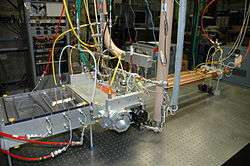ElectricOIL

The Electric Oxygen Iodine Laser, or ElectricOIL, or EOIL, is an infrared hybrid electrical / chemical laser. Its output wavelength is 1.315 µm, the wavelength of transition of atomic iodine. The lasing state I* is produced by near-resonant energy transfer with the singlet oxygen metastable O2(a1Δ) [denoted hereafter as O2(a)].
Advantages
EOIL technology represents a unique class of hybrid electric gas high-energy laser with the potential to have inherently higher beam quality than solid state systems, while being more logistically friendly than current Chemical Oxygen Iodine Laser (COIL) systems. The principal advantage of such an inherently high beam quality system is the trade of a relatively small fixed mass in electrical generation and heat exchanger hardware for the massive fluid supply and large tankage associated with COIL devices.
Development
Since the first reporting of a viable electric discharge-driven oxygen-iodine laser system (also often referred to as EOIL or DOIL in the literature) by CU Aerospace (CUA) and the University of Illinois at Urbana Champaign (UIUC),[1][2] there have been a number of other successful demonstrations of gain [3][4] and laser power.[4][5][6] Computational modeling of the discharge and post-discharge kinetics [7][8] has been an invaluable tool in EOIL development, allowing analysis of the production of various discharge species [O2(a1Δ), O2(b1Σ), O atoms, and O3] and determination of the influence of NOX species on system kinetics. Ionin et al.[9] and Heaven [10] provide comprehensive topical reviews of discharge production of O2(a) and various EOIL studies. The highest gain in an EOIL device reported to date is 0.30% / cm, and the highest output power reported is 538 W.[11] Over the past five years of research and development of the EOIL device, higher performance and efficiency have been consistently obtained by moving towards higher operating flow rates and pressures.
References
- ↑ http://apl.aip.org/resource/1/applab/v85/i8/p1320_s1
- ↑ http://apl.aip.org/resource/1/applab/v86/i11/p111104_s1
- ↑ http://www.psicorp.com/pdf/library/sr-1229.pdf
- 1 2 "IEEE Xplore - Continuous wave operation of a non-self-sustained electric discharge pumped oxygen-iodine laser". Ieeexplore.ieee.org. 2011-09-27. doi:10.1063/1.2408668. Retrieved 2012-12-07.
- ↑ http://www.psicorp.com/SR-1323.pdf
- ↑ "Gain and output power measurements in an electrically excited oxygen–iodine laser with a scaled discharge - Abstract - Journal of Physics D: Applied Physics - IOPscience". Iopscience.iop.org. Retrieved 2012-12-07.
- ↑ "IEEE Xplore - O2(1Δ) production in He/O2 mixtures in flowing low pressure plasmas". Ieeexplore.ieee.org. 2011-09-27. doi:10.1063/1.1768615. Retrieved 2012-12-07.
- ↑ "Oxygen Discharge and Post-Discharge Kinetics Experiments and Modeling for the Electric Oxygen−Iodine Laser System† - The Journal of Physical Chemistry A (ACS Publications)". Pubs.acs.org. Retrieved 2012-12-07.
- ↑ "Physics and engineering of singlet delta oxygen production in low-temperature plasma - Abstract - Journal of Physics D: Applied Physics - IOPscience". Iopscience.iop.org. Retrieved 2012-12-07.
- ↑ "Recent advances in the development of discharge-pumped oxygen-iodine lasers - Heaven - 2010 - Laser & Photonics Reviews - Wiley Online Library". Onlinelibrary.wiley.com. 2010-06-07. Retrieved 2012-12-07.
- ↑ "IEEE Xplore - Superlinear Enhancement of Discharge Driven Electric Oxygen-Iodine Laser by Increasing". Ieeexplore.ieee.org. 2011-09-27. doi:10.1109/JQE.2011.2177246. Retrieved 2012-12-07.